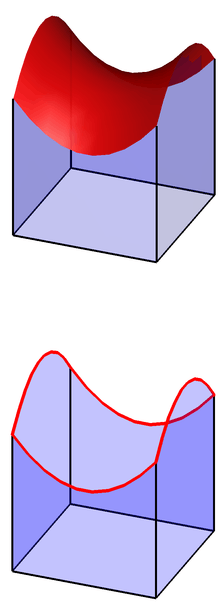Trace operator

In mathematics, the concept of trace operator plays an important role in studying the existence and uniqueness of solutions to boundary value problems, that is, to partial differential equations with prescribed boundary conditions. The trace operator makes it possible to extend the notion of restriction of a function to the boundary of its domain to "generalized" functions in a Sobolev space.
Informal discussion
Let be a bounded open set in the Euclidean space with C1 boundary If is a function that is (or even just continuous) on the closure of its function restriction is well-defined and continuous on . In other words, it is clear what the values of on the boundary should be because the function is continuous as we move from the interior to the boundary of the domain. We then call that function the "trace" of that at each point of the boundary has the same values as the limit of when we move from the interior of toward . (Remember that is an open set, so boundary points are not in and consequently itself is not defined at boundary points.)
If however, is the solution to some partial differential equation, it is in general a weak solution and only belongs to some Sobolev space. Such functions are in general not continuous, and the operation "limit of when we move from the interior of toward " that we used above may not be allowed for some because the limit does not yield a unique value for all sequences of points that converge to . It follows that simple function restriction cannot be used to meaningfully define the trace of weak functions.
The way out of this difficulty is the observation that while an element in a Sobolev space may be ill-defined as a function, can be nevertheless approximated by a sequence of functions defined on the closure of Then, the restriction of to is defined as the limit of the sequence of restrictions . An alternative approach uses the fact that functions in most Sobolev spaces may be discontinuous at some points, but "not too many". For example, in 2d, functions in the space (i.e., the space in which the solution lies for many partial differential equations) can be discontinuous at individual points, but not along lines. Consequently, the limit of a function may be undefined at individual points on the boundary, but not along the entire boundary, and one can define the trace as that function (or one of those functions) that matches the limit of "almost everywhere" on the boundary.
Construction of the trace operator
To rigorously define the notion of restriction to a function in a Sobolev space, let be a real number. Consider the linear operator
defined on the set of all functions on the closure of with values in the Lp space given by the formula
The domain of is a subset of the Sobolev space It can be proved that there exists a constant depending only on and such that
- for all in
Then, since the functions on are dense in , the operator admits a continuous extension
defined on the entire space is called the trace operator. The restriction (or trace) of a function in is then defined as
This argument can be made more concrete as follows. Given a function in consider a sequence of functions that are on with converging to in the norm of Then, by the above inequality, the sequence will be convergent in Define
It can be shown that this definition is independent of the sequence approximating
Application
Consider the problem of solving Poisson's equation with zero boundary conditions:
Here, is a given continuous function on
With the help of the concept of trace, define the subspace to be all functions in the Sobolev space (this space is also denoted ) whose trace is zero. Then, the equation above can be given the weak formulation
- Find in such that
- for all in
Using the Lax–Milgram theorem one can then prove that this equation has precisely one solution, which implies that the original equation has precisely one weak solution.
One can employ similar ideas to prove the existence and uniqueness of solutions for more complicated partial differential equations and with other boundary conditions (such as Neumann and Robin), with the notion of trace playing an important role in all such problems.
References
- Evans, Lawrence (1998). Partial differential equations. Providence, R.I.: American Mathematical Society. pp. 257–261. ISBN 0-8218-0772-2.
- Leoni, Giovanni (2017). A First Course in Sobolev Spaces: Second Edition. Graduate Studies in Mathematics. 181. American Mathematical Society. pp. 734. ISBN 978-1-4704-2921-8